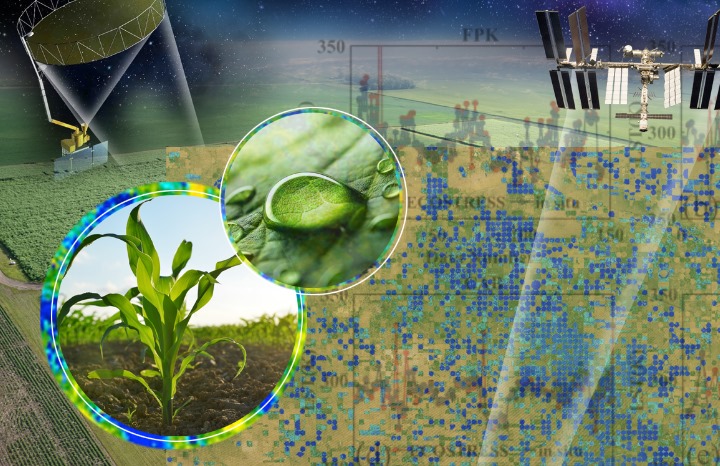
Using satellite-based sensor, a research team headed by agronomy professor Brian Hornbuckle aims to estimate the water content of plants in fields across the Corn Belt. Photos courtesy of NASA and Brian Hornbuckle.
Want to know if a plant is happy? How its pores are working can tell you a lot.
Thriving plants respond to sunlight by opening their stomata, the thousands of microscopic holes on their leaves, to draw in the carbon dioxide needed for photosynthesis. But opening those pores also releases water vapor, a process called transpiration. So plants struggling with too little water tend to keep their stomata closed to conserve precious moisture. And like animals unable to perspire, plants that don’t transpire can get too hot.
A research team led by Iowa State University agronomy professor Brian Hornbuckle is studying how to use satellite-based sensors to remotely detect how stomata are functioning in fields across the Corn Belt by estimating daily changes in plant water content and temperature, which could act as an early warning system for crop stress.
“Plants should look really juicy in the morning and a little dried out in the evening, if they have enough soil water,” Hornbuckle said. “If they don’t have enough soil water, they’ll be reluctant to open their stomata and there won’t be much change in their moisture level. That should mean you’ve got a stressed plant.”
The three-year project, funded by a NASA grant of about $536,000, will combine data from two of NASA’s orbiting observatories. The Soil Moisture Active Passive (SMAP) satellite detects microwave radiation emanating from Earth, which is affected by the amount of water in soil and vegetation. The ECOsystem Spaceborne Thermal Radiometer Experiment (ECOSTRESS) is aboard the International Space Station and measures plant temperatures using infrared radiation. Satellite readings will be validated in part by comparing them to on-the-ground measurements of water in corn growing on a research plot near Ames.
This is Hornbuckle’s ninth NASA grant and builds on prior experience working with SMAP and a similar microwave-detecting satellite operated by the European Space Agency, Soil Moisture and Ocean Salinity (SMOS). Both SMOS and SMAP were designed to measure soil moisture, and researchers previously built models to filter out the signal from water held in plants. Now, the filtering is flipped.
“We still want to know about water in soil, but the water actually in plants is what we care about in this study,” he said.
While the measurements will cover a broad area, roughly the size of an Iowa county, additional data about crop stress could complement tools such as drought maps, Hornbuckle said. If tracking day-to-day changes in plant water content and temperature proves useful for identifying crop stress, a drone-mounted system would provide a granular look at individual fields. Remote aerial monitoring ensures data is regularly collected, with little labor or field access required.
“This could help farmers better understand the health of their crops, allowing for improved economic decision-making,” he said.
Hornbuckle said the research also will contribute to the ever-growing understanding of how water moving between Earth’s surface and atmosphere affects weather and climate, one of the overall goals of monitoring moisture levels with satellites. Real-time soil moisture data is already being used by Canadian meteorologists and the U.S. Air Force to improve forecasts. Using real-time evapotranspiration data from SMAP and ECOSTRESS could be next.
“It nudges weather models closer to reality,” he said.
Source : iastate.edu